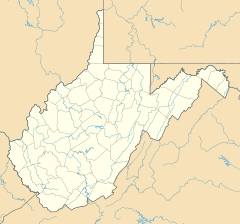Beartown, West Virginia facts for kids
Quick facts for kids
Beartown
|
|
|---|---|
| Country | United States |
| State | West Virginia |
| County | McDowell |
| Time zone | UTC-5 (Eastern (EST)) |
| • Summer (DST) | UTC-4 (EDT) |
| GNIS feature ID | 1553823 |
Beartown is a small, unincorporated community located in McDowell County, West Virginia, in the United States. It is not a city or town with its own local government. Instead, it is a group of homes and businesses that are part of the larger county. Beartown is situated along the Norfolk and Western Railroad and near a waterway called Dry Fork.
Contents
What is an Unincorporated Community?
An unincorporated community is a place where people live that is not officially organized as a city or town. This means it does not have its own mayor or city council. Instead, the county government handles services like roads, police, and fire protection. Many small communities, especially in rural areas, are unincorporated.
Life in Unincorporated Areas
Living in an unincorporated community can be different from living in a city. Residents often rely on county services. They might also form local groups to help with community projects. These areas often have a close-knit feel, with neighbors knowing each other well.
Where is Beartown Located?
Beartown is found in the southwestern part of West Virginia. This state is known for its beautiful mountains and forests. It is often called the "Mountain State." West Virginia is part of the Appalachian region of the United States.
McDowell County: A Look at the Area
Beartown is in McDowell County. This county is in the southern part of West Virginia. It is known for its rich history in coal mining. For many years, coal was a very important industry here. The county's landscape is rugged, with many hills and valleys.
Geography of McDowell County
McDowell County has a varied landscape. It features many ridge and valley formations. The Appalachian Mountains dominate the scenery. Rivers and streams cut through the land, creating deep valleys. This geography made coal mining both challenging and rewarding.
The Norfolk and Western Railroad
The Norfolk and Western Railroad played a huge role in the development of many communities in West Virginia, including Beartown. Railroads were essential for transporting coal from the mines to other parts of the country. They also brought supplies and people into these remote areas.
Railroads and Coal Mining
In the late 1800s and early 1900s, railroads were the main way to move coal. The Norfolk and Western line connected coalfields to major cities and ports. This allowed the coal industry to grow rapidly. Many towns, like Beartown, grew up along these rail lines. The railroad provided jobs and connected communities.
Impact on Local Communities
The arrival of the railroad changed life in places like Beartown. It made it easier for people to travel and for goods to be traded. The railroad brought new opportunities but also new challenges. It helped shape the economy and culture of the region for many decades.
Dry Fork: A Local Waterway
Beartown is located along Dry Fork. A "fork" in a river usually means a branch or a smaller stream that flows into a larger one. Dry Fork is a tributary of the Tug Fork River. These waterways are important parts of the local ecosystem.
Rivers and Streams in West Virginia
West Virginia has many rivers and streams. They are vital for wildlife and provide water for communities. Historically, these waterways were also used for transportation. Today, they are popular for outdoor activities like fishing and kayaking.
History of the Region
The history of McDowell County and surrounding areas is deeply tied to its natural resources. Before the arrival of European settlers, Native American tribes lived in the region. Later, pioneers moved into the area, drawn by the land and its potential.
The Coal Boom
The discovery of vast coal reserves in the late 19th century transformed the region. People from all over came to work in the mines. This led to the rapid growth of towns and communities. The coal industry brought both prosperity and hardship to the area.
Life in Coal Camps
Many communities in coal regions were originally "coal camps." These were towns built by mining companies for their workers. They often included housing, stores, and schools. Life in these camps was unique, centered around the mining operations.
Modern Beartown
Today, Beartown remains a small community. While the coal industry has changed, the history of mining is still a big part of the area's identity. Residents enjoy the quiet, rural lifestyle and the natural beauty of the Appalachian Mountains.
Community Life
Like many small communities, Beartown has a strong sense of local pride. People often come together for events and to support each other. The pace of life is generally slower than in big cities. This allows for a close connection to nature and neighbors.
See also
 In Spanish: Beartown (Virginia Occidental) para niños
In Spanish: Beartown (Virginia Occidental) para niños



